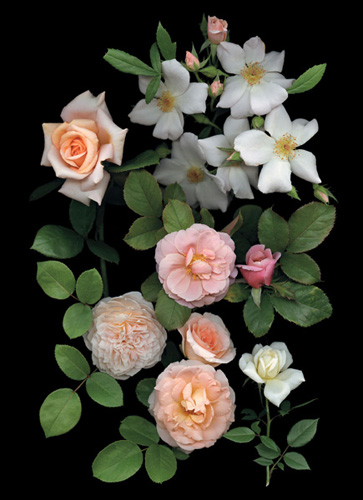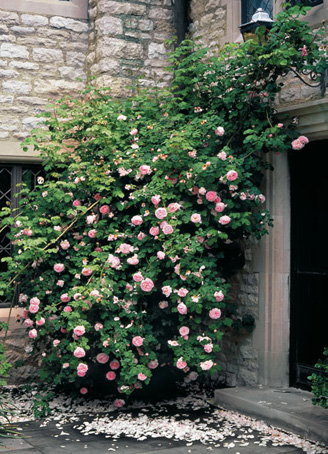
Types of roses are categorized by class: A hybrid tea ‘Sunset Celebration’; B tall modern shrub rose, hybrid musk ‘Sally Homes’; C miniature ‘Constellation’; D shrub (English rose) ‘Royal Wedding’; E shrub (English rose) ‘English Garden’; F shrub rose ‘Distant Drums’.

There are some 100 species in the genus Rosa in the family Rosaceae. They have existed for millennia and grow around the world, including a handful of North American species found in places like the tallgrass prairies of the Midwest, the West Coast, and in the East. I grow near-white Rosa carolina (Carolina rose) and pink R. palustris (the swamp rose), which I believe I saw growing in a drainage ditch near my garden in northwest New Jersey. The ubiquitous “wild” beach rose (R. rugosa) is a species that originated in Japan and Korea and came to U.S. shores in the 1850s. This salt- and wind-tolerant rose with crinkled leaves is considered an invasive exotic in many places where it has pushed out local species.
Natural, pre-hybridized species are considered one class of roses. Then there are old garden roses (those in cultivation before 1847 when the first hybrid tea ‘La France’ was introduced), and there are several classes among the modern roses that followed. Hybrid tea roses are the most popular of the modern rose classes, with pointed buds on long stems and thirty to forty angular petals on flowers with high centers. Hybrid teas are generally susceptible to disease, but these vase-shaped bushes bloom on and off through the season. Floribunda roses are useful landscape shrubs to four feet that are easier to care for, with flowers resembling hybrid teas born in trusses with multiple blossoms open at a time. One standby is white-flowered ‘Iceberg’. Longer-stemmed grandiflora roses are larger shrubs that originated as crosses between hybrid tea and floribunda varieties, first introduced in 1954 with ‘Queen Elizabeth’. Polyantha roses are twiggy, thorny short plants with large clusters of small flowers and are often repeat bloomers.
Miniature rose plants are like hybrid teas and floribundas, but the flowers are much smaller and on plants only fifteen to twenty inches tall. Mini-flora, or patio roses fall between miniature and floribunda roses in size. The classification of “shrub rose” comprises a variety of plants including hybrid kordesii, hybrid moyesii, hybrid musk, hybrid rugosa, and hybridizer David Austin’s English roses.
Large-flowered climbing roses have long arching canes that need supports to lean on. Ramblers, or hybrid Wichuraiana roses, are not always considered a class. They are once-blooming sprawling plants that cover the ground or, like my monster ‘American Pillar’, arch from fence post to fence posts. The bloom time is late, but flowers continue for four weeks in summer.
The first David Austin introduction was ‘Constance Spry’ in 1960.
